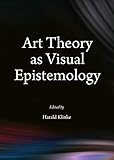Art theory as visual epistemology / edited by Harald Klinke.
Language: English Publication details: UK : Cambridge Scholars Publishing, 2014.ISBN:- 9781443854399
 Print
Print
| Item type | Home library | Collection | Call number | Status | Date due | Barcode | |
|---|---|---|---|---|---|---|---|
 Print
Print
|
OPJGU Sonepat- Campus Main Library | General Books | 701.15 AR- (Browse shelf(Opens below)) | Available | 146035 |
Browsing OPJGU Sonepat- Campus shelves, Collection: General Books Close shelf browser (Hides shelf browser)
"How can we “know”? What does “knowledge” mean? These were the fundamental questions of epistemology in the 17th century. In response to continental rationalism, the British empiricist John Locke proposed that the only knowledge humans can have is acquired a posterior. In a discussion of the human mind, he argued, the source of knowledge is sensual experience – mostly vision.Since vision and picture-making are the realm of art, art theory picked up on questions such as: are pictures able to represent knowledge about the world? How does the production of images itself generate knowledge? How does pictorial logic differ from linguistic logic? How can artists contribute to a collective search for truth? Questions concerning the epistemic potential of art can be found throughout the centuries up until the present day. However, these are not questions of art alone, but of the representational value of images in general. Thus, the history of art theory can contribute much to recent discussions in Visual Studies and Bildwissenschaften by showing the historic dimension of arguments about what images are or should be. “What is knowledge?” is as much a philosophic question as “What is an image?”Visual epistemology is a new and promising research field that is best investigated using an interdisciplinary approach that addresses a range of interconnected areas, such as internal and external images and the interplay of producer and perceiver of images. This publication outlines this territory by gathering together several approaches to visual epistemology by many distinguished authors."--
There are no comments on this title.








